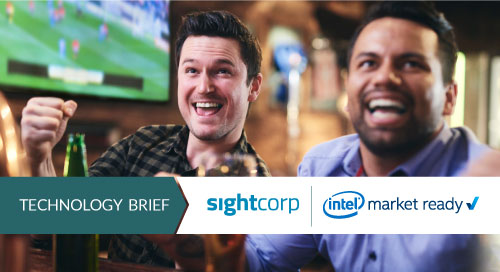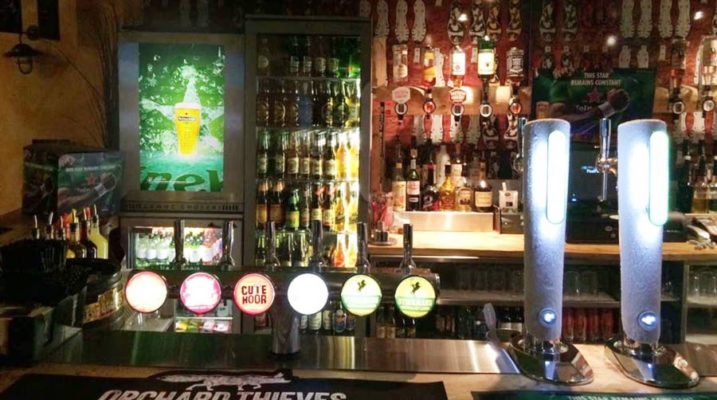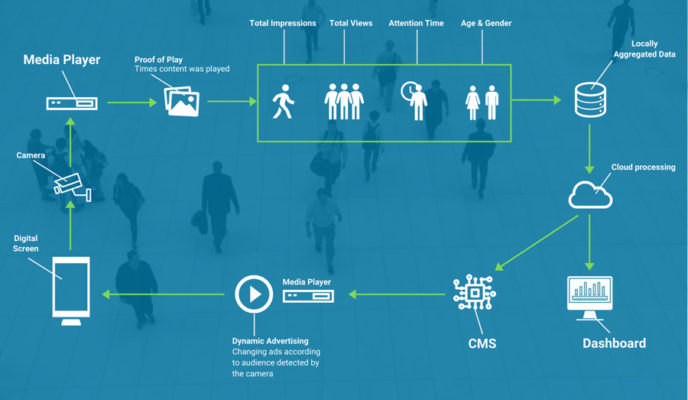Serve Up Custom Content With Digital Displays

In today’s retail environment, digital screens with embedded cameras are becoming increasingly more central to our day-to-day interactions. New technologies are making digital displays smarter—enabling targeted content and impression-based insights for measuring campaign reach.
More than ever, store owners are under new pressures to keep both staff and customers safe. Automated and tailored communications can help with monitoring and limiting the number of people that can enter. And displaying real-time messaging such as capacity, number of people inside, wait time, and mask detection aid compliance with local regulations.
And screens can, for example, remind people to sanitize their hands around supermarket produce areas, while at the same time showing highly targeted ads. This way intelligent digital displays play an important role in providing the experiences that customers and employees want and need.
Tapping Into AI Technology
With the integration of AI and computer vision, digital displays are creating new opportunities to understand audience demographic profiles and engage with target groups. No longer limited to static signage, they can attract consumers with customized, compelling, and targeted content.
Better yet, brands benefit from actionable business intelligence, to test and measure advertising success. Much as they do with online marketing, brands need detailed analytics to learn how, when, and why consumers respond to their campaigns, as well as data on performance and reach of those campaigns.
The problem is that traditional and manual data collection techniques are outdated and no longer work in the digital world. Viewer counts are often inaccurate, and these systems can’t deliver detailed insights or continuous feedback.
“Most marketers can only take an educated guess about how their campaigns are performing, and have no direction to optimize their content,” said Joyce Caradonna, CEO at Sightcorp. “There just isn’t much insight into the audience. It’s hard to know if the ad is working, who is watching it, and what the response is.”
Adding video cameras and AI-enabled edge devices, Heineken could see how many people passed by and viewed its displays, for how long, and their demographic profiles. @sightcorp
Digital Signage at Work
Case in point is Heineken, the Dutch beer brand well known around the world. The company lacked visibility and clarity into how consumers were responding to its marketing initiatives—specifically in pubs around the city of Dublin. For these sites, Heineken had three goals:
- Deliver targeted content to the right people at the right time
- Maximize the conversion rates and ROI of cooler displays
- Gather data on ad performance across different venues
To achieve these objectives, the company worked with Focal Media, a systems integrator specializing in digital signage and custom analytics. They partnered to deploy the Sightcorp Toolkit across 100 Heineken venues around the city (Figure 1).

The cross-platform, plug-and-play software was integrated with the existing cooler displays, preserving past investments. Adding video cameras and AI-enabled edge devices, Heineken was able to learn how many people passed by and viewed its displays, for how long, and their demographic profiles.
The software is deployed on the Intel® processor-based Scala media player. Here it processes facial data in real time, then instructs the player to trigger a relevant ad based on the current composition of the audience—storing that data for further analysis. This continuous feedback loop and continual testing enables Heineken to continually improve performance.
It can then compare the analytics to point-of-sale and revenue data for each venue to learn if its targeted ads have a positive effect on conversion and sales.
The Toolkit brings detailed marketing analytics to the physical space, breaking down customer data into several categories, including people count, opportunity to see (OTS), age, gender, viewers, impressions, attention time, dwell time, and mood. And by using the Intel® OpenVINO™ Toolkit as a framework, Sightcorp was able to significantly improve the speed and accuracy of face detection, gender estimation, and other features.
Such information enables the Heineken marketing team to better understand who is viewing its campaigns and how they are responding. The CMS provides time and location stamps for each ad to identify what content played when, for how long, and on which screen. This data is then compared with audience data to understand which ad performs best and for which viewer category.
“The system can actually distinguish between someone who is just passing by and not looking at the display versus a person who is actually paying attention,” Caradonna said.
Facial Recognition—Anonymous Data
A “privacy by design” approach collects data anonymously. As a frame comes into the camera, the software converts it into pixels and binary code for analysis. The video frame is discarded immediately, enabling the company to gather actionable intelligence while adhering to privacy regulations.
“All you are left with is raw, anonymous data providing trends about demographics,” said Caradonna.
The resulting data is then pushed to the Scala content management system (CMS) and Skyfii dashboard for analysis. The solution can be used alongside any existing screens or signage. And the flexibility to use the Skyfii dashboard or any other third-party analytics tool (e.g., Microsoft PowerBI) enables data from multiple venues and technologies to be tracked and managed all in one platform (Figure 2).

Heineken can now A/B-test different creatives and establish which are more effective in driving engagement and sales. The results so far show a positive effect of customized ads when compared to similar venues that do not use the Sightcorp solution.
“While many brands just present mass content without targeting based on audience insights and hope for the best, our software enables you to actually segment and only push the right content to the right persona type,” said Caradonna.
Not only can Heineken improve its revenue through advertising, customers get a better pub experience—and the desire to return, again and again.